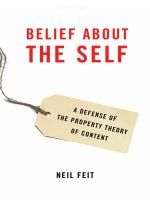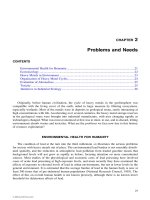Teach english, teach about the environment a resource for teachers of adult english for speakers of other languages (ESOL)
Bạn đang xem bản rút gọn của tài liệu. Xem và tải ngay bản đầy đủ của tài liệu tại đây (1.9 MB, 133 trang )
Teach English, Teach About
the Environment
A Resource for Teachers of Adult English for Speakers of Other Languages (ESOL) Table of Contents
Introduction . . . . . . . . . . . . . . . . . . . . . . . . . . . . . . . . . . . . . i
Note to Instructors . . . . . . . . . . . . . . . . . . . . . . . . . . . . . . ii
Lesson Plans . . . . . . . . . . . . . . . . . . . . . . . . . . . . . . . . . . . . . 1
Beginning Level . . . . . . . . . . . . . . . . . . . . . . . . . . . . . . . . . . 3
Intermediate Level . . . . . . . . . . . . . . . . . . . . . . . . . . . . . . 14
Advanced Level . . . . . . . . . . . . . . . . . . . . . . . . . . . . . . . . . 25
Appendices . . . . . . . . . . . . . . . . . . . . . . . . . . . . . . . . . . . . . 35
Appendix 1: Training ESOL Teachers . . . . . . . . . . . . . . . . . . 37
Preparing for Training . . . . . . . . . . . . . . . . . . . 38
Conducting the Training Session . . . . . . . . . . . . 38
Appendix 2: Using this Resource . . . . . . . . . . . . . . . . . . . . . 39
Accessing United States Environmental
Protection Agency Resources . . . . . . . . . . . . . . . 39
Background Information . . . . . . . . . . . . . . . . . . 40
Appendix 3: Flash Facts . . . . . . . . . . . . . . . . . . . . . . . . . . . 43
Appendix 4: Picture Files . . . . . . . . . . . . . . . . . . . . . . . . . 101 Introduction
As a teacher of English for Speakers of Other Languages (ESOL), you know that your
classes are extremely popular with immigrants and long-term visitors to the United
States. These classes provide not only the opportunity to learn English but can
serve as a portal through which many newcomers pass as a first step in integrating
themselves into their new communities and American society.
The Environmental Protection Agency (EPA) has developed the Teach English, Teach
about the Environment curriculum to help you teach English to adult students while
introducing basic concepts about the environment and individual environmental
responsibility. These concepts can help the newly-arrived be part of cleaner and
healthier communities by understanding and practicing the “3Rs” of solid waste
management – reduce, reuse, recycle. “Background Information – The 3Rs of Solid
Waste Management” on page 40 should be read before using this curriculum.
The curriculum uses a hands-on, multi-sensory, multi-media approach to show how
personal behavior can improve the overall environmental well-being of the family,
home, and community. Lesson plans are provided for the beginner, intermediate
and advanced student. Each lesson plan has a language as well as an environmental
objective. It also provides background on the environmental objective, a list of materials
needed, a glossary of terms used in that lesson and a worksheet. Lessons should be
introduced when the adult learner is already familiar with the grammatical construction
emphasized in the materials. Flash cards and picture files are also included.
We hope that you find Teach English, Teach about the Environment a useful and
interesting resource for your students.
i
Note to Instructors
The Teach English, Teach About the Environment curriculum is a series of lessons
related to reducing, reusing and recycling waste. The lesson plans in the curricu-
lum should be introduced after the adult learner is already familiar with the gram-
matical constructions emphasized in the materials. The curriculum should be used
as a supplement to your traditional teaching materials.
You should introduce and teach the vocabulary, as most students would probably
be unfamiliar with environmentally-related words.
ii
Teach English, Teach About the Environment
A Resource for Teachers of Adult English for Speakers of
Other Languages (ESOL)
Lesson Plans
Intermediate Level
Beginning Level
Advanced Level
1
Solid Waste Focus: Recycle
Environmental Objective
Identify common environmental values held in the United States related to recycling, reusing
and reducing the waste stream.
Materials Needed
Pictures a, b, c, d and e
Flash Facts 1, 2, 3 and 7
Newspapers, aluminum cans, glass bottles, plastic containers, boxes color-coded to match marked
(glass, paper, plastic) receptacles for recycling.
Background for the Teacher
Recycling is an important way we can save energy and conserve natural resources. Many
communities require residents to recycle and provide special color-coded receptacles for sorting
and collecting the items to be recycled. Become familiar with your community’s procedures for
recycling. Determine if there are any penalties for failing to recycle.
Language Objectives
1. Simple present tense first person singular and plural
Examples: “I recycle glass.” “We recycle newspaper.”
2. Adjective-noun order
Examples: glass bottle, aluminum can
Vocabulary
aluminum newspaper (s) glass
plastic can (s) recycle bottle (s)
Procedures
1. Post Flash Facts and pictures before class arrives. Arrange recyclable items on a table.
2. Review related Flash Facts. Emphasize how recycling helps to conserve natural
resources.
3. Examples: “I recycle newspaper.” “I recycle glass.” “I recycle plastic.” Place the items
being recycled in the appropriate container. Use related picture files as your model.
4. Take items out and have students say the same phrases as a group.
5. Have groups of students say “I recycle _______________” depending on what type of
item the teacher holds up.
Teach English, Teach About the Environment
3
A Resource for Teachers of Adult English for
Speakers of Other Languages (ESOL)
Beginning Level Lesson Plan 1
6. Ask pairs of students to volunteer to say the correct phrase depending on what item
is being held up.
7. See if individuals are willing to try the activity alone. Do not force them to talk if
they do not want to.
8. Repeat 2, 3, 4 and 5 using “we” instead of “I”.
9. Provide students with Worksheet #1. Show one answer on the board.
10. Assign Civic Integration Activity and Home Support Activity.
11. Have students report back what they observed. Emphasize how the words they’ve
learned relate to values in the United States.
Civic Integration Activity
1. Ask students to observe whether their neighbors recycle their waste.
2. Ask students to observe whether the school or their workplace recycles waste material.
3. Ask at the following class what they observed.
Home Support Activity
1. Have students identify what items they could have recycled over a week’s time. List
items. Discuss which natural resources would be conserved if the items were recycled.
Relate to Worksheet #2
2. Have students weigh themselves on their bathroom scale at home. Then have them
weigh themselves with the bag of household garbage thrown out each day. Multiply the
weight difference by seven days, 30 days, and 365 days to get a sense of the amount
of garbage generated by each student. Chart on board. Compare to Flash Fact #1.
Teach English, Teach About the Environment
4
A Resource for Teachers of Adult English for
Speakers of Other Languages (ESOL)
Beginning Level Worksheet 1
Name: _____________________________________________ Date: _________________
Fill in the missing letters.
1. I __ __ __ __ __ __ __ newspaper.
2. I recycle aluminum __ __ __ __ .
3. I recycle __ __ __ __ __ __ __ .
4. I __ __ __ __ __ __ __ g __ __ __ __ .
5. __ r __ __ __ __ __ __ newspaper.
6. W __ __ __ __ __ __ __ __ aluminum __ __ __ __ .
7. __ r __ __ y __ __ __ n __ __ __ __ __ __ __ __ __ .
8. We __ __ __ __ __ __ __ c __ __ __ .
9. We __ __ __ __ __ __ __ __ __ __ s s .
10. __ e __ __ __ __ __ __ __ p __ __ __ __ __ __ .
Teach English, Teach About the Environment A Resource for Teachers of Adult English for
5
Speakers of Other Languages (ESOL)
Beginning Level Lesson Plan 2
Solid Waste Focus: Recycle
Environmental Objective
Identify common ways to recycle in our daily lives.
Materials Needed
Pictures a, b, c, d, e, f
Flash Facts 1, 3, 5 ,6, 7
Additional Materials - Newspapers, aluminum cans, glass bottles, plastic containers, boxes color-
coded to match community receptacles for recycling.
Background for the Teacher
Recycling includes collecting, sorting and processing certain solid waste into raw materials for
re-manufacture into new items. Look for a “c” on the bottom of plastic containers. It means the
container can be recycled. Many recyclable plastics can also be identified by the letters HDPE
(milk jugs) and PET (soda bottles).When consumers purchase products manufactured from recycled
material they close the recycling loop.
Language Objectives
1. Review simple present tense first person singular and plural
2. Introduce second person.
Example: “You recycle newspaper.”
3. Introduce third person singular.
Examples: “He recycles ___________.”
“She recycles __________.”
4. Introduce plural forms with “s”.
Example: “She recycles ____________”.
Vocabulary
aluminum newspaper (s) natural resources
plastic recycle can (s)
glass conserve bottle(s)
Teach English, Teach About the Environment
6
A Resource for Teachers of Adult English for
Speakers of Other Languages (ESOL)
Beginning Level Lesson Plan 2
Procedures
1. Arrange recyclables and receptacle boxes on the table. Have several examples of each
recyclable on the table.
2. Review with class: “I recycle ___________.” “We recycle _______________.”
3. Have class provide choral response.
4. Repeat with “He recycles _________.” She recycles __________.”
5. Reinforce plural “s” forms: “I recycle glass bottles.” “We recycle glass bottles.” Hold up
examples as the class repeats the activity. Repeat for all items.
6. Form small circles of 6 to 10 students and model.
7. “I recycle newspaper.” “You recycle newspaper.” Point to a person and accentuate
“you”. Continue around the circle, passing the items as they speak.
8. Change the items until every group has used newspaper, can(s), glass, and plastic.
9. Discuss other ways to recycle in our daily lives.
10. Identify the natural resources. Ask how recycling helps to conserve natural resources.
11. Have students complete Worksheet #2.
Civic Integration Activity
1. Have students recycle items used or consumed during breaks. Example: cans, bottles,
plastic or newspaper.
2. Have them deposit recyclables in the containers as they come in from break.
Home Support Activity
Have students create a recycling-related picture with a younger family member or friend. See
“How My Family Recycles” at www.epa.gov/osw/kids/pdfs/jellyjar.pdf. Select a picture to color.
Discuss the page selected.
Teach English, Teach About the Environment
7
A Resource for Teachers of Adult English for
Speakers of Other Languages (ESOL)
Beginning Level Worksheet 2
Name: _____________________________________________ Date: ____________________
I, You, and We
A. Complete
p __ __ __ __ __ __ g __ __ __ __
b __ __ __ __ __ __
n __ __ __ __ __ __ __ __
B. Complete
1. I recycle newspapers.
W __ __ __ __ __ __ __ __ __ __ __ __ __ bottles.
Y ___ ___ __ __ __ __ __ __ __ __ __ __ __ __ bottles.
2. I recycle glass.
W __ __ __ __ __ __ __ __ __ __ __ __ __ __ __ .
Y ___ ___ __ __ __ __ __ __ __ __ __ __ __ __ .
Teach English, Teach About the Environment A Resource for Teachers of Adult English for
8
Speakers of Other Languages (ESOL)
Beginning Level Lesson Plan 3
Solid Waste Focus: Reuse
Environmental Objective
Identify reuse of common items normally thrown away.
Materials Needed
Pictures a, b, c, d, g, h
Flash Facts 1, 3, 5, 6, and 7
Additional Materials - Plastic jug, aluminum can, glass bottle
Background for the Teacher
There are many creative ways to reuse items which might normally find their way into the waste
stream: old shoe boxes can be used for storage, plastic containers for planters, etc. Students can
also donate or give away items rather than throwing these items into the waste stream. For a
large number of unwanted items, students can hold a garage sale. They can also be encouraged
to shop at garage sales before buying new!
Language Objectives
1. Interrogatives with “How”
2. Responses with “Can” for possibility
Vocabulary
aluminum can (s) plastic reuse
container (s) produce source reduction
garbage product (s) waste
natural resources recyclable
Procedures
1. Explain to the class that reuse of an item is a way to save our natural resources.
2. Pair students or create small groups of three to discuss how to reuse each of the items
in the picture from the Picture Files. Allow students three to five minutes per item to
brainstorm.
3. Have students report to class by pairs or groups. Ask: “How can you reuse a glass
bottle?”, “How can you use a plastic container?”
a. I can reuse a glass bottle to/for _________.
b. I/we can reuse plastic containers for/to ________.
c. I/we can reuse plastic containers for/to ________.
Teach English, Teach About the Environment
9
A Resource for Teachers of Adult English for
Speakers of Other Languages (ESOL)
Beginning Level Lesson Plan 3
4. List responses on board. Review how reuse of items reduces the waste stream,
contributes to source reduction, and conserves resources.
5. Have students complete Worksheet #3.
6. Assign Civic Integration and Home Support Activities.
7. Have students report back what they observed. Have students display their creative
reuse of items.
Civic Integration Activity
Ask students to observe ways local businesses or their neighbors may have reused items to
decorate or for practical purposes; for example, turning used tires into planters.
Home Support Activity
Ask students to reuse an item in a creative way. Have them bring the item(s) to class for display.
Vote on the most creative, prettiest, etc. Give prizes or paper ribbons.
Teach English, Teach About the Environment
10
A Resource for Teachers of Adult English for
Speakers of Other Languages (ESOL)
Beginning Level Worksheet 3
Answer each question.
1. How can you reuse the bottle?
I can reuse it for a _________________________________.
2. How can we reuse the plastic jug?
We can_______________________ it for _______________.
3. How can they reuse the egg carton?
They can reuse the_______________ for _______________.
4. How can we reuse the grocery bags?
We can reuse them for ______________________________.
5. How can we reuse the boxes?
_______________________________ for ________________.
Teach English, Teach About the Environment A Resource for Teachers of Adult English for
11
Speakers of Other Languages (ESOL)
Beginning Level Lesson Plan 4
Solid Waste Focus: Reduce
Environmental Objective
Identify easy ways to reduce the waste stream.
Materials Needed
Pictures a, b, c, d, g, h, and i
Flash Facts 1, 5, 6, 8, 9
Background for the teacher
There are many other ways in which we can avoid adding to the waste stream. Some manufacturers
package their products with oversized polystyrene foam. Students should be made aware of exces-
sive packaging and how to minimize it, if possible. One way to minimize packaging is to buy in
bulk. Other ways to reduce waste include donating unwanted items to charities, holding a class
swap meet to exchange unwanted items, and buying at garage sales.
Language Objectives
1. Interrogative words: How, Which
3. Plural forms
Vocabulary
charity (ies) swap meet (s) donate
church (es) unwanted packaging
exchange waste stream garage sale (s)
Procedures
1. Review how reducing waste helps to reduce the waste stream. Have the students
repeat, “We buy in bulk.” “We donate old clothes.” “We swap items we don’t need
for items we do need.”
2. Have the students to pair off and allow them to speak in their native language.
Assign students to think of other ways to reduce the waste stream. Ask “How can
we reduce the waste stream?”
3. Bring the class back together and have the pairs report their ideas.
4. List their ideas on the board.
5. Emphasize the value of donating unwanted items to churches or charities. Ask students
which local churches or charities might welcome donations.
Teach English, Teach About the Environment
12
A Resource for Teachers of Adult English for
Speakers of Other Languages (ESOL)
Beginning Level Lesson Plan 4
6. Ask students if anyone ever gave a friend or family member something they no
longer used. Share the idea of a swap meet where students bring in items they no
longer want, and, in turn, swap or give the item to fellow classmates. Emphasize
how the leftover items could be donated to a church or charity.
7. Using the students display the items collected and conduct an in-class swap meet.
Donate any leftover items.
8. Summarize ways to reduce the waste stream. Emphasize how reducing the waste
stream conserves natural resources.
Civic Integration Activity
Using the churches or charities identified in Procedure 5, have the students collect items for
them. Donate the items.
Home Support Activity
Assign students to collect unwanted but usable items to either swap in class or to donate to a
specified church or charity.
Teach English, Teach About the Environment
13
A Resource for Teachers of Adult English for
Speakers of Other Languages (ESOL)
Intermediate Level Lesson Plan 1
Solid Waste Focus:
Recycling, Reusing, Reducing
Environmental Objective
Compare and contrast environmental values held in the United States related to recycling,
reusing, and reducing to those held in countries represented by students in the adult ESOL class.
Materials Needed
Pictures k, a, b, c, d, e, f, i
Flash Facts 6, 10, 11, 12, 15, 16, 17
Photos of trees, recycling receptacles, excessive packaging, glass, cans, etc.
Background for the Teacher
Recycling saves natural resources. It also saves energy and reduces human impacts on the climate.
Paper and aluminum are recycled with great success. Successful recycling, reducing and reusing
means less depletion of dwindling natural resources. International values related to recycling,
reusing and reducing may vary. Compare and contrast your students’ values related to recycling,
reusing, and reducing.
Language Objectives
1. Questions with auxiliary verb “Did”
2. Interrogative words “What,” “Why,” “How”
3. Simple past tense responses
Vocabulary
container (s) reusable forest (s)
excessive shopping bag (s) waste stream
packaging paper mill (s) item (s)
Teach English, Teach About the Environment
14
A Resource for Teachers of Adult English for
Speakers of Other Languages (ESOL)
Intermediate Level Lesson Plan 1
Procedures
1. Post pictures and flash facts before class arrives.
2. Discuss the beauty of the natural environment reflected in the picture of the trees.
Ask if forests exist in their countries. “Did you have forests in your country?” Chart
responses by country.
a. Did you recycle paper in your country?
b. Did you recycle other products?
3. Ask: Did you reuse items in your homeland?
Have students pair off and discuss how they reused items in their homelands. Give
them five minutes to discuss, and then share responses. Chart answers by country,
listing what items were reused and how they were reused.
4. Discuss pictures showing excessive packaging. Was so much packaging really needed?
Why do manufacturers like excessive packaging? Have students compare and
contrast ways they could reduce excessive use of packaging. Examples might include
selecting products with less packaging, using reusable shopping bags, and writing
the manufacturers.
5. Wrap up by reviewing the class chart. Emphasize the importance of conserving natural
resources by reducing, reusing and recycling waste.
Civic Integration Activity
Have students hold an in-class “unwanted items” meet to exchange or sell items they do not
need or use. Explain how exchanging is a form of recycling.
Home Support Activity
1. Have students interview families about solid waste disposal in their homelands. Use
attached interview sheet.
2. Have students collect and bring in examples of the ways they reuse items they might
have ordinarily discarded. Display reused items. Select the most creative, most original,
and most unusual and give prizes for each.
Teach English, Teach About the Environment
15
A Resource for Teachers of Adult English for
Speakers of Other Languages (ESOL)
Intermediate Level Support Activity
Name: _____________________________________________ Date: ____________________
1. How was solid waste handled in your homeland? Was it collected, and taken to a
landfill? Burned? Who took care of these activities?
2. What were people’s attitudes toward waste?
3. Were people concerned about conserving natural resources?
4. Other comments.
Teach English, Teach About the Environment A Resource for Teachers of Adult English for
16
Speakers of Other Languages (ESOL)
Intermediate Level Lesson Plan 2
Solid Waste Focus: Recycle
Environmental Objective
Compare and contrast ways people recycle in each of the students’ countries to recycling in the
United States.
Materials Needed
Pictures (a) through (f)
Flash Facts 1, 2, 3, 10, 12, 13, 14, 15, 16, 17 and 18
Background for the Teacher
Many communities conduct curbside recycling. After the recyclables are collected, they are trans-
ported to a collection center where they are sorted and sent to facilities that can process them
into new materials or products. Buying recycled closes the recycling loop.
Language Objectives
1. Simple past tense with an emphasis on pronunciation of the final syllable
2. Interrogative words: What, How, Why, Which
3. Plural with “s” with an emphasis on pronunciation of plural sounds
Vocabulary
aluminum paper newspaper(s)
penalty (ies) container (s) plastic (s)
jar (s) glass magazines (s)
collection fine (s)
Procedures
1. Post Pictures and Flash Facts before class arrives.
2. Using the Picture Files, discuss recycling in the United States. Refer to the symbol for
recycling on containers and the types of items which are recycled. Review the benefits
of recycling by referring to the Flash Facts which have been posted. Elicit additional
examples of recycling from the students’ experiences in the community. Stress the
importance of purchasing items made from recycled material.
3. Pair or group students by home countries. Allow them five to seven minutes to discuss
recycling as practiced in their home countries and have them list examples. Have pairs/
groups share recycling practices from their home countries and chart on the board.
Have pairs respond to “What did you recycle and why?” Be sure they pronounce any
plural sounds used.
Teach English, Teach About the Environment
17
A Resource for Teachers of Adult English for
Speakers of Other Languages (ESOL)
Intermediate Level Lesson Plan 2
4. When all groups/pairs have reported, ask which items they recycle in the
United States.
5. Compare and contrast recycling practices.
6. Assign Civic Integration and Home Support activities.
Civic Integration Activity
Have students determine whether their communities require residents to recycle. Access the
community website on the Internet or call City Hall. Ask local businesses (photocopy center,
service station, etc.) if they recycle.
Home Support Activity
Have students create a poster with their families describing why they should recycle. Display
posters. Have students describe their posters. If students wish to be more creative, they can
create a collage from recyclables.
Teach English, Teach About the Environment
18
A Resource for Teachers of Adult English for
Speakers of Other Languages (ESOL)
Intermediate Level Lesson Plan 3
Solid Waste Focus: Reuse
Environmental Objective
Compare and contrast ways people reuse items both in the United States and in the students’
native countries.
Materials Needed
Pictures a, b, c, d, g, and h
Flash Facts 2, 5, 9, 14, 17, 18
Background for the Teacher
Throughout the world, people have been very resourceful in reusing items. Your students may
contribute very creative and clever ways containers are recycled for other uses, including children’s
games, planters, etc. Reusing items helps save energy and conserves natural resources.
Language Objectives
1. Interrogative words with simple past tense
Examples: “How did?” “Why did?” “What did?”
2. Simple past responses
Examples: “I reused.” “We reused.”
3. Plural with “s” with an emphasis on pronunciation of plural sounds
Vocabulary
charity (ies) reusable garage sale (s)
donate recycled content product (s)
Procedures
1. Post Pictures and Flash Facts before class arrives.
2. Remind students how recycling and reusing items made of glass, aluminum or plastic
helps to conserve our natural resources. Use Pictures Files a, b, c, and d to illustrate
your point. Incorporate the Flash Facts into your discussion of reducing the waste
stream. Relate these facts to conserving resources.
3. Pair/group students to discuss ways people reused glass, aluminum or plastic items in
their native lands. Allow them to share for five to seven minutes. Elicit responses to
“My neighbor reused ___________.”
Teach English, Teach About the Environment
19
A Resource for Teachers of Adult English for
Speakers of Other Languages (ESOL)
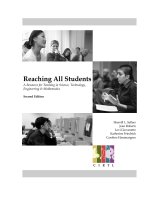
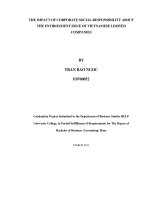
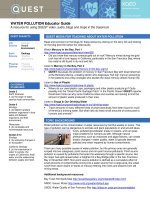


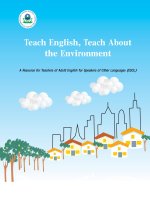
![vmware esx and esxi in the enterprise [electronic resource] planning deployment of virtualization servers](https://media.store123doc.com/images/document/14/y/mx/medium_mxh1401475429.jpg)
